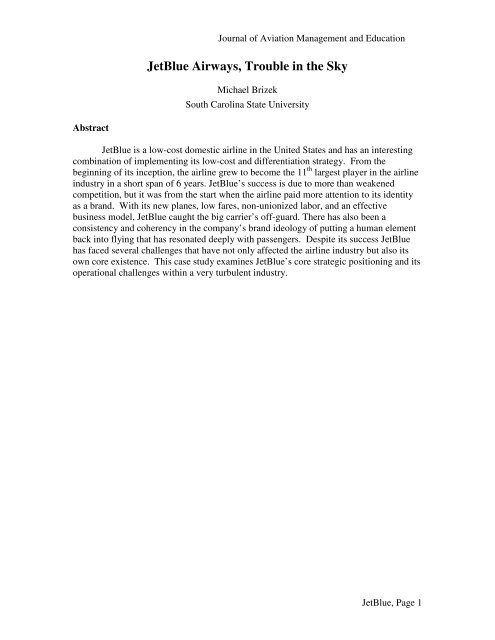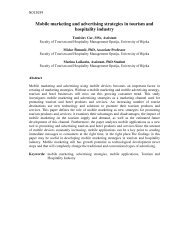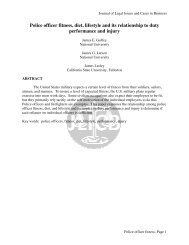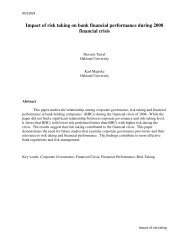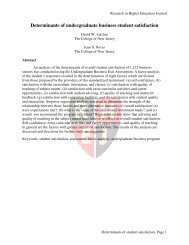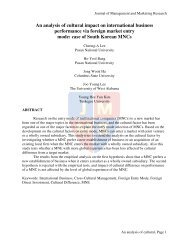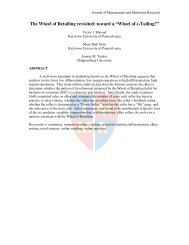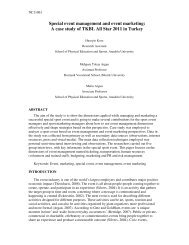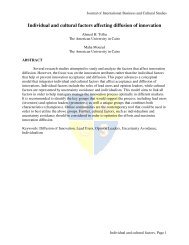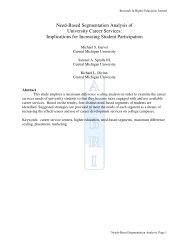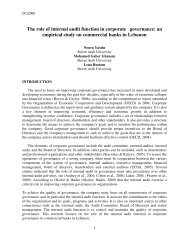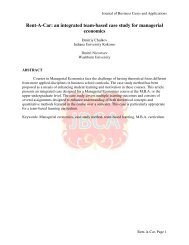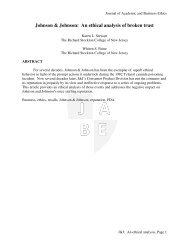JetBlue Airways, Trouble in the Sky
JetBlue Airways, Trouble in the Sky
JetBlue Airways, Trouble in the Sky
- TAGS
- jetblue
- airways
- www.aabri.com
Create successful ePaper yourself
Turn your PDF publications into a flip-book with our unique Google optimized e-Paper software.
Abstract<br />
Journal of Aviation Management and Education<br />
<strong>JetBlue</strong> <strong>Airways</strong>, <strong>Trouble</strong> <strong>in</strong> <strong>the</strong> <strong>Sky</strong><br />
Michael Brizek<br />
South Carol<strong>in</strong>a State University<br />
<strong>JetBlue</strong> is a low-cost domestic airl<strong>in</strong>e <strong>in</strong> <strong>the</strong> United States and has an <strong>in</strong>terest<strong>in</strong>g<br />
comb<strong>in</strong>ation of implement<strong>in</strong>g its low-cost and differentiation strategy. From <strong>the</strong><br />
beg<strong>in</strong>n<strong>in</strong>g of its <strong>in</strong>ception, <strong>the</strong> airl<strong>in</strong>e grew to become <strong>the</strong> 11 th largest player <strong>in</strong> <strong>the</strong> airl<strong>in</strong>e<br />
<strong>in</strong>dustry <strong>in</strong> a short span of 6 years. <strong>JetBlue</strong>’s success is due to more than weakened<br />
competition, but it was from <strong>the</strong> start when <strong>the</strong> airl<strong>in</strong>e paid more attention to its identity<br />
as a brand. With its new planes, low fares, non-unionized labor, and an effective<br />
bus<strong>in</strong>ess model, <strong>JetBlue</strong> caught <strong>the</strong> big carrier’s off-guard. There has also been a<br />
consistency and coherency <strong>in</strong> <strong>the</strong> company’s brand ideology of putt<strong>in</strong>g a human element<br />
back <strong>in</strong>to fly<strong>in</strong>g that has resonated deeply with passengers. Despite its success <strong>JetBlue</strong><br />
has faced several challenges that have not only affected <strong>the</strong> airl<strong>in</strong>e <strong>in</strong>dustry but also its<br />
own core existence. This case study exam<strong>in</strong>es <strong>JetBlue</strong>’s core strategic position<strong>in</strong>g and its<br />
operational challenges with<strong>in</strong> a very turbulent <strong>in</strong>dustry.<br />
<strong>JetBlue</strong>, Page 1
INTRODUCTION<br />
Overview of <strong>the</strong> Organization<br />
Journal of Aviation Management and Education<br />
<strong>JetBlue</strong> <strong>Airways</strong> was <strong>in</strong>corporated <strong>in</strong> Delaware <strong>in</strong> August 1998. The <strong>Airways</strong><br />
headquarters is based out of Forest Hills, New York. <strong>JetBlue</strong>’s ma<strong>in</strong> hub is based out of<br />
JFK airport, <strong>in</strong> New York City. <strong>JetBlue</strong> is a low-cost domestic airl<strong>in</strong>e <strong>in</strong> <strong>the</strong> United<br />
States and has an <strong>in</strong>terest<strong>in</strong>g comb<strong>in</strong>ation of implement<strong>in</strong>g its low-cost and<br />
differentiation strategies. From <strong>the</strong> beg<strong>in</strong>n<strong>in</strong>g of its <strong>in</strong>ception, <strong>the</strong> airl<strong>in</strong>e grew to become<br />
<strong>the</strong> 11 th largest player <strong>in</strong> <strong>the</strong> airl<strong>in</strong>e <strong>in</strong>dustry <strong>in</strong> a short span of 6 years (<strong>JetBlue</strong> <strong>Airways</strong>,<br />
n.d.).<br />
The current CEO, David Neeleman, founded <strong>the</strong> company <strong>in</strong> February of 1999<br />
under <strong>the</strong> name of NewAir. Most of <strong>the</strong> executives of <strong>JetBlue</strong> <strong>in</strong>clud<strong>in</strong>g Neeleman are<br />
former Southwest employees. What <strong>JetBlue</strong> <strong>in</strong>tended to do was to offer low fare flights<br />
designed to stimulate demand. In addition to its low fares, <strong>the</strong> company offered unique<br />
products that differentiated it from o<strong>the</strong>r airl<strong>in</strong>es. The way <strong>the</strong>y dist<strong>in</strong>guish <strong>the</strong>mselves<br />
from o<strong>the</strong>r airl<strong>in</strong>es are <strong>the</strong> products that are offered such as; new aircrafts, lea<strong>the</strong>r seats,<br />
reliable operat<strong>in</strong>g performance, 36 channels of Live TV and movie selections from Fox<br />
In-flight at every seat (<strong>JetBlue</strong> <strong>Airways</strong>, n.d.).<br />
“<strong>JetBlue</strong> was launched with a huge amount of capital, brand new planes, and<br />
expert personal <strong>in</strong> key positions. It grew rapidly as customers flocked to it to escape <strong>the</strong><br />
steep fares and frequent delays of <strong>the</strong> major airl<strong>in</strong>es” (<strong>JetBlue</strong> <strong>Airways</strong>, n.d.). In <strong>the</strong> early<br />
1990s many small start up airl<strong>in</strong>es also tried <strong>the</strong> low fare formula but failed <strong>in</strong> <strong>the</strong> face of<br />
direct competition from <strong>the</strong> major airl<strong>in</strong>es, which were able to withstand <strong>the</strong> fare wars.<br />
S<strong>in</strong>ce 1978 more <strong>the</strong>n 97 airl<strong>in</strong>es failed because of <strong>in</strong>sufficient capital and <strong>in</strong>sufficient<br />
management talent (<strong>JetBlue</strong> <strong>Airways</strong>, n.d.).<br />
Accord<strong>in</strong>g to Neeleman it took thirty months of plann<strong>in</strong>g to get his next project<br />
dubbed New Air <strong>in</strong> <strong>the</strong> skies. Neeleman raised $130 million dollars <strong>in</strong> start up capital<br />
from backers that <strong>in</strong>clude Chase Capital partners ($20 million); Quantum and Soros Fund<br />
Management ($40 million); and Western Presidio from S.F. ($30 million). Banc Boston<br />
Ventures, Massachusetts Mutual Life and Nations Bank Montgomery Securities all<br />
contributed 10 million dollars each. A group led by Neeleman also <strong>in</strong>vested $10.2 million<br />
dollars <strong>in</strong>to <strong>the</strong> company (<strong>JetBlue</strong> <strong>Airways</strong>, n.d.).<br />
Talented executives were brought <strong>in</strong> from o<strong>the</strong>r airl<strong>in</strong>es and o<strong>the</strong>r executives were<br />
brought <strong>in</strong> from Southwest. The company’s operation is similar to Southwest <strong>in</strong> that <strong>the</strong>y<br />
shared similar ideas and concepts. For example, <strong>JetBlue</strong> used <strong>the</strong> Airbus A320, which<br />
was similar to <strong>the</strong> Boe<strong>in</strong>g 737’s used by Southwest. (Our History, n.d.)<br />
In mid July of 1999 NewAir changed its name to <strong>JetBlue</strong> <strong>Airways</strong> and by <strong>the</strong> next<br />
year it launched its operations with its <strong>in</strong>augural flight between JFK airport <strong>in</strong> New York<br />
and Fort Lauderdale, Florida. Neeleman once said that his goal was to, “br<strong>in</strong>g <strong>the</strong><br />
humanity back to air travel.” <strong>JetBlue</strong> aimed to undercut o<strong>the</strong>r airl<strong>in</strong>es’ fares by an<br />
average of 65%. This bold move by <strong>JetBlue</strong> showed frequent travelers how cheap it could<br />
be to fly compared to o<strong>the</strong>r airl<strong>in</strong>ers. This change of fares had an effect on <strong>the</strong> entire<br />
airl<strong>in</strong>e <strong>in</strong>dustry caus<strong>in</strong>g larger airl<strong>in</strong>ers to start compet<strong>in</strong>g as well (<strong>JetBlue</strong> <strong>Airways</strong>, n.d.).<br />
The ma<strong>in</strong> reason why customers are so amazed by <strong>JetBlue</strong> was <strong>the</strong> amenities that<br />
<strong>the</strong>y offered to <strong>the</strong>ir customers. The <strong>in</strong>-flight enterta<strong>in</strong>ment system showed live satellite<br />
<strong>JetBlue</strong>, Page 2
Journal of Aviation Management and Education<br />
broadcasts where as o<strong>the</strong>r airl<strong>in</strong>es had recorded shows that <strong>the</strong>y showed to passengers<br />
dur<strong>in</strong>g flights. The airl<strong>in</strong>e would serve no meal but offered gourmet potato chips and soda<br />
on all <strong>the</strong>ir flights. These were some of <strong>the</strong> market<strong>in</strong>g concepts that were brought <strong>in</strong> by<br />
executives that use to work for Virg<strong>in</strong> Atlantic <strong>Airways</strong>. One th<strong>in</strong>g <strong>JetBlue</strong> lacked <strong>in</strong> was<br />
<strong>the</strong> frequent flyer mile program, which was not appeal<strong>in</strong>g to <strong>the</strong> high mileage bus<strong>in</strong>ess<br />
travelers.<br />
<strong>JetBlue</strong> bus<strong>in</strong>ess grew rapidly <strong>the</strong> first year that <strong>the</strong>y were <strong>in</strong> <strong>the</strong> sky. The 300<br />
call center employees <strong>in</strong> Salt Lake City, who had <strong>the</strong> options of work<strong>in</strong>g at home and<br />
sav<strong>in</strong>g <strong>the</strong> company overhead, were receiv<strong>in</strong>g 12,000 calls a day. Still <strong>the</strong> company was<br />
book<strong>in</strong>g 40 percent of its flights through <strong>the</strong> air (<strong>JetBlue</strong> <strong>Airways</strong>, n.d.)<br />
In December of 2000, Neeleman’s <strong>JetBlue</strong> airl<strong>in</strong>es recorded its millionth<br />
customer flier and <strong>the</strong> third profitable month, which was an amaz<strong>in</strong>g achievement <strong>in</strong> such<br />
a short time. It also reported $100 million dollars <strong>in</strong> revenue but not <strong>in</strong> annual profit. The<br />
company at this time was only operat<strong>in</strong>g out of ten dest<strong>in</strong>ations. The company’s plan is to<br />
acquire a new plane every five weeks until 2008 to meet its demand. <strong>JetBlue</strong> <strong>in</strong> June<br />
2001 announced that it was go<strong>in</strong>g to buy as many as 48 planes for as much as $2.5<br />
billion. The company also wanted to <strong>in</strong>crease its flight frequency on its exist<strong>in</strong>g route<br />
ra<strong>the</strong>r than expand<strong>in</strong>g its number of markets served. (Miranda, 2007)<br />
In July 2001 <strong>the</strong> Port Authority of New York approved a new five year, $60<br />
million dollar lease and New Jersey gave <strong>JetBlue</strong> control of its own term<strong>in</strong>al at JFK.<br />
<strong>JetBlue</strong> later decided to lease a few gates to United Airl<strong>in</strong>es. As <strong>JetBlue</strong> expanded and<br />
became more popular it also received awards and accolades such as <strong>in</strong> 2007 <strong>the</strong>y won <strong>the</strong><br />
best domestic airl<strong>in</strong>e for value by <strong>the</strong> Travel + Leisure magaz<strong>in</strong>e, #3 rated airl<strong>in</strong>e by<br />
Fortune magaz<strong>in</strong>e, and <strong>in</strong> 2006 <strong>JetBlue</strong> won passenger service award by Air Transport<br />
World magaz<strong>in</strong>e. These are few of <strong>the</strong> many awards and recognitions that <strong>JetBlue</strong> has<br />
received throughout its years of service (“<strong>JetBlue</strong> <strong>Airways</strong>,” n.d.).<br />
Airl<strong>in</strong>e Industry<br />
To better understand <strong>the</strong> profitability and risks <strong>in</strong>volved <strong>in</strong> <strong>the</strong> airl<strong>in</strong>e <strong>in</strong>dustry;<br />
one must know a little about <strong>the</strong> <strong>in</strong>dustry as a whole. In order to understand how new<br />
aircraft might fit <strong>in</strong>to <strong>the</strong> current market; one must understand <strong>the</strong> customer (Airl<strong>in</strong>e<br />
Industry, n.d.). As we all know air travel rema<strong>in</strong>s a large and grow<strong>in</strong>g <strong>in</strong>dustry. It<br />
facilitates economic growth, world trade, <strong>in</strong>ternational <strong>in</strong>vestment and tourism and it’s<br />
<strong>the</strong>refore central to <strong>the</strong> market. In <strong>the</strong> past decade, air travel has grown by 7%.<br />
Accord<strong>in</strong>g to <strong>the</strong> latest statistics given by <strong>the</strong> International Air Transport Association<br />
(IATA) travel for both bus<strong>in</strong>ess and leisure purposes has grown dramatically worldwide.<br />
As companies became <strong>in</strong>creas<strong>in</strong>gly <strong>in</strong>ternational <strong>in</strong> terms of <strong>the</strong>ir <strong>in</strong>vestments, <strong>the</strong>ir<br />
supply and production cha<strong>in</strong>s felt a sharp <strong>in</strong>crease <strong>in</strong> <strong>the</strong> amount of air travel. Scheduled<br />
airl<strong>in</strong>es carried 1.5 billion passengers last year. The IATA forecasts that <strong>in</strong>ternational air<br />
travel will grow by an average of 6.6% a year to <strong>the</strong> end of <strong>the</strong> decade and over 5% a<br />
year from 2000 to 2010. These rates are very similar to <strong>the</strong> ones that occurred <strong>in</strong> <strong>the</strong> past<br />
ten years (Airl<strong>in</strong>e Industry, n.d.).<br />
To meet <strong>the</strong> requirements of <strong>the</strong>ir <strong>in</strong>creas<strong>in</strong>gly discern<strong>in</strong>g customers, some<br />
airl<strong>in</strong>es have to <strong>in</strong>vest heavily <strong>in</strong> <strong>the</strong> quality of service that <strong>the</strong>y offer, both on <strong>the</strong> ground<br />
and <strong>in</strong> <strong>the</strong> air. Ticket-less travel, new <strong>in</strong>teractive enterta<strong>in</strong>ment systems, and more<br />
<strong>JetBlue</strong>, Page 3
Journal of Aviation Management and Education<br />
comfortable seat<strong>in</strong>g are just some of <strong>the</strong> product enhancements be<strong>in</strong>g <strong>in</strong>troduced to attract<br />
and reta<strong>in</strong> customers (Airl<strong>in</strong>e Industry, n.d.). <strong>JetBlue</strong> is now ahead of <strong>the</strong> game due to <strong>the</strong><br />
<strong>in</strong>itiative that it took early on concern<strong>in</strong>g <strong>the</strong>se issues.<br />
When <strong>the</strong> September 11 th attack on <strong>the</strong> US happened, <strong>the</strong> airl<strong>in</strong>e <strong>in</strong>dustry was hit<br />
<strong>the</strong> hardest and disruption and chaos was caused throughout <strong>the</strong> country and <strong>in</strong> <strong>the</strong> airl<strong>in</strong>e<br />
<strong>in</strong>dustry. The nation’s three major airl<strong>in</strong>es, Delta, American, and United Airl<strong>in</strong>es, all<br />
suffered great loses and each airl<strong>in</strong>es had to cutback on employees by 20 percent just to<br />
stay afloat. Only two airl<strong>in</strong>es ended up mak<strong>in</strong>g money <strong>in</strong> <strong>the</strong> post-9/11 economy and one<br />
of <strong>the</strong>m was <strong>JetBlue</strong>. The ma<strong>in</strong> reason why <strong>the</strong>y didn’t suffer as much was because <strong>the</strong>y<br />
were offer<strong>in</strong>g low fares and po<strong>in</strong>t-to-po<strong>in</strong>t ra<strong>the</strong>r than a network service, and by focus<strong>in</strong>g<br />
on second-tier airports ra<strong>the</strong>r than go<strong>in</strong>g head to head aga<strong>in</strong>st established hub. Today,<br />
<strong>JetBlue</strong> has a market value that is nearly as large as that of United, American and Delta<br />
comb<strong>in</strong>ed (Frost, 2006.).<br />
<strong>JetBlue</strong>’s success is due to more than weakened competition, but it was from <strong>the</strong><br />
start when <strong>the</strong> airl<strong>in</strong>e paid more attention to its identity as a brand. With its new planes,<br />
low fares, non-unionized labor, and an effective bus<strong>in</strong>ess model, <strong>JetBlue</strong> caught <strong>the</strong> big<br />
carrier’s off-guard. There has also been a consistency and coherency <strong>in</strong> <strong>the</strong> company’s<br />
brand ideology of putt<strong>in</strong>g a human element back <strong>in</strong>to fly<strong>in</strong>g that has resonated deeply<br />
with passengers.<br />
Gareth Edmondson-Jones, <strong>JetBlue</strong>’s Vice-President of Corporate Communication<br />
said, “<strong>JetBlue</strong> has prospered more significantly by its brand work than by disruption after<br />
9/11. It’s certa<strong>in</strong>ly a comb<strong>in</strong>ation, but more so <strong>the</strong> brand. More importantly, it was <strong>the</strong><br />
pre-9/11 era that did most damage to <strong>the</strong> legacy carriers, when <strong>the</strong>y were mak<strong>in</strong>g massive<br />
profits with poor quality, <strong>in</strong>different service and high fares. That was <strong>the</strong> platform upon<br />
which <strong>JetBlue</strong> launched. September 9/11 certa<strong>in</strong>ly meant that <strong>the</strong> big guys were<br />
distracted while we grew” (British Design Innovation, n.d.)<br />
Operat<strong>in</strong>g Doma<strong>in</strong><br />
As for <strong>JetBlue</strong>’s operat<strong>in</strong>g doma<strong>in</strong>, it is believed that due to its web-based<br />
book<strong>in</strong>g, <strong>in</strong>stead of book<strong>in</strong>g through ticket<strong>in</strong>g agents, <strong>the</strong> airl<strong>in</strong>e is able to ga<strong>in</strong> greater<br />
control on manag<strong>in</strong>g seat sales which <strong>in</strong> turn avoids customers be<strong>in</strong>g bumped. As for <strong>the</strong><br />
operations, <strong>JetBlue</strong> uses paperless cockpit, no meals served on any of its flights, and no<br />
paper-tickets, which all reduce time and costs. They also use a s<strong>in</strong>gle aircraft type, which<br />
<strong>in</strong> <strong>the</strong> long run keeps tra<strong>in</strong><strong>in</strong>g costs low, and manpower utilization at a high. Ano<strong>the</strong>r<br />
way that <strong>JetBlue</strong> utilizes it resources is by us<strong>in</strong>g <strong>the</strong> new A320s, which are larger and<br />
more fuel-efficient. <strong>JetBlue</strong> also has less congested airports, which helps to speed flight<br />
departures and get <strong>the</strong>ir passengers to <strong>the</strong>ir dest<strong>in</strong>ations <strong>in</strong> a faster manner. Some of <strong>the</strong><br />
market<strong>in</strong>g techniques that <strong>JetBlue</strong> uses are web-based ticket<strong>in</strong>g, which is <strong>the</strong>n used as a<br />
distribution channel. They have a sophisticated market segment properly identified for<br />
<strong>the</strong> bus<strong>in</strong>ess travelers fly<strong>in</strong>g po<strong>in</strong>t-to-po<strong>in</strong>t and of course effective pric<strong>in</strong>g which gives<br />
<strong>the</strong>m <strong>the</strong> edge aga<strong>in</strong>st <strong>the</strong>ir competitors (Evans, 2007).<br />
As for service, <strong>JetBlue</strong> is always <strong>in</strong> constant communication with customers to<br />
keep <strong>the</strong>m <strong>in</strong>formed of changes or <strong>in</strong>conveniences. Customers are refunded sometimes<br />
when <strong>the</strong>re are <strong>in</strong>conveniences, which is a big plus for customers that loose luggage or<br />
delay of flights. Neeleman, himself travels regularly to get customer feedback first-hand.<br />
<strong>JetBlue</strong>, Page 4
Journal of Aviation Management and Education<br />
<strong>JetBlue</strong> as a company also <strong>in</strong>vests <strong>in</strong> tra<strong>in</strong><strong>in</strong>g for service orientation. Ano<strong>the</strong>r attribute<br />
that <strong>the</strong> company holds is that <strong>the</strong>y have well-conceived aircraft procurement plan to<br />
support future growth.<br />
<strong>JetBlue</strong> <strong>in</strong>vests <strong>in</strong> technology <strong>in</strong>itiatives such as automated baggage handl<strong>in</strong>g,<br />
web-based ticket<strong>in</strong>g, paperless cockpit etc. <strong>JetBlue</strong>,s non-unionized workforceis<br />
<strong>in</strong>centivized through rewards systems such as stock-option plans, profit shar<strong>in</strong>g,<br />
<strong>in</strong>novative recruitment policies and culture promot<strong>in</strong>g camaraderie’s.<br />
Extracted from: (Porter, M.E.) <strong>JetBlue</strong>’s Activity System. November-December 1996.<br />
Harvard Bus<strong>in</strong>ess Review).<br />
Operational Problem<br />
One of <strong>the</strong> biggest disasters that happened <strong>in</strong> <strong>JetBlue</strong> history took place on<br />
Valent<strong>in</strong>e’s Day, February 14, 2007, a high air-traffic day. Caught by a bad w<strong>in</strong>ter storm<br />
and bad airl<strong>in</strong>e plann<strong>in</strong>g, <strong>JetBlue</strong> passengers ended up spend<strong>in</strong>g as many as 11 hours<br />
trapped on planes on a frozen tarmac <strong>in</strong> New York. Flights throughout <strong>the</strong> nation were<br />
stranded due to bad plann<strong>in</strong>g. Customer service was damaged for <strong>JetBlue</strong>, as most people<br />
were not happy with <strong>the</strong> long amount of time <strong>the</strong>y were spend<strong>in</strong>g on <strong>the</strong> planes. Even<br />
though <strong>JetBlue</strong> offered refunds and o<strong>the</strong>r perks to customers <strong>the</strong>re reputation was still<br />
tarnished as passengers compared <strong>the</strong>se long delays as hostage situations (Ross, 2007).<br />
One passenger said it <strong>the</strong> best who was stuck on one of <strong>the</strong> airl<strong>in</strong>es for 11 hours,<br />
“Noth<strong>in</strong>g says ‘I love you’ like be<strong>in</strong>g held hostage on a frozen plane with <strong>the</strong> man you<br />
<strong>JetBlue</strong>, Page 5
Journal of Aviation Management and Education<br />
love, 99 strangers, 4 o<strong>the</strong>r people you happen to know, 4 scream<strong>in</strong>g babies and 3<br />
rambunctious kids runn<strong>in</strong>g about, noth<strong>in</strong>g but chips and soda for sustenance, faulty<br />
power, unreliable direct TV and overfilled sewage system for 11 hours” (Bailey, 2007).<br />
Passengers on all airl<strong>in</strong>es experienced delays and cancelled flights, yet <strong>JetBlue</strong><br />
was <strong>the</strong> airl<strong>in</strong>e mak<strong>in</strong>g it <strong>in</strong>to <strong>the</strong> news for <strong>the</strong> excruciat<strong>in</strong>gly long runway delays,<br />
cancellation of all flights, and long wait to claim baggage. Although <strong>the</strong>re was no way<br />
<strong>JetBlue</strong> could have prevented <strong>the</strong> cancelled flights due to bad wea<strong>the</strong>r, <strong>the</strong>y did not have<br />
risk management plan <strong>in</strong> effect address<strong>in</strong>g ice storms before this <strong>in</strong>cident occurred<br />
(Levick, 2007). Most o<strong>the</strong>r airl<strong>in</strong>es responded by cancel<strong>in</strong>g more flights earlier, send<strong>in</strong>g<br />
passengers home and resum<strong>in</strong>g <strong>the</strong>ir schedules with<strong>in</strong> a day or two. But <strong>JetBlue</strong> thought<br />
<strong>the</strong> wea<strong>the</strong>r would break and it would be able to fly, keep<strong>in</strong>g its revenue flow<strong>in</strong>g and its<br />
customers happy.<br />
The <strong>JetBlue</strong> crisis started on a Wednesday, but its woes dragged on day after day.<br />
By <strong>the</strong> follow<strong>in</strong>g Saturday night 23 percent of <strong>JetBlue</strong> flights were cancelled for Saturday<br />
and Sunday and would also be canceled Monday. This confusion led to angry exchanges<br />
between customers and employees, promot<strong>in</strong>g <strong>the</strong> airl<strong>in</strong>e to call out security personnel.<br />
Before <strong>the</strong> February 14 th <strong>in</strong>cidents happened, <strong>JetBlue</strong> was named <strong>the</strong> number one J.D.<br />
Powers customer service oriented airl<strong>in</strong>e among low-cost carriers. With <strong>the</strong> debacle that<br />
happened <strong>JetBlue</strong> must take airl<strong>in</strong>e customer service to even a higher precedent as issues<br />
such as passenger rights, gett<strong>in</strong>g planes off <strong>the</strong> ground on time, and employee empathy<br />
are addressed (Associated Press, 2007).<br />
David G. Neeleman <strong>the</strong> founder and CEO of <strong>JetBlue</strong> airl<strong>in</strong>es said he was<br />
humiliated and mortified by <strong>the</strong> huge breakdown <strong>in</strong> <strong>the</strong> airl<strong>in</strong>e’s operation that has<br />
dragged on for nearly a week, and promised that <strong>in</strong> <strong>the</strong> future <strong>JetBlue</strong> would pay penalties<br />
to customers if <strong>the</strong>y were stranded on a plane for too long. He also admitted that <strong>the</strong><br />
current crises which led to about 1,000 cancelled flights <strong>in</strong> five days, was <strong>the</strong> result of a<br />
shoestr<strong>in</strong>g communications system that left pilots and flight attendants <strong>in</strong> <strong>the</strong> dark, and<br />
undersized reservation systems. S<strong>in</strong>ce <strong>the</strong> airl<strong>in</strong>e was founded <strong>in</strong> 1999 it was often cited<br />
as a favorite among passengers and expanded rapidly, but its system to deal with <strong>the</strong><br />
consequences of bad wea<strong>the</strong>r did not keep up with <strong>the</strong> growth. The company’s low cost<br />
operat<strong>in</strong>g structure may have been a contribut<strong>in</strong>g factor that caused this mess (Bailey,<br />
2007).<br />
A basic problem was <strong>JetBlue</strong>’s communication system. The ice storm had left a<br />
large portion of <strong>the</strong> airl<strong>in</strong>e’s 11,000 pilots and flight attendants far from where <strong>the</strong>y<br />
needed to be to operate <strong>the</strong> planes, and <strong>JetBlue</strong> lacked <strong>the</strong> tra<strong>in</strong>ed staff that was needed to<br />
f<strong>in</strong>d <strong>the</strong>m and tell <strong>the</strong>m where to go. It was <strong>the</strong> first time <strong>in</strong> <strong>the</strong> company’s history that<br />
<strong>the</strong>y had so many people out of position. Ano<strong>the</strong>r problem was <strong>the</strong> reservation system;<br />
<strong>the</strong> system was so overwhelmed that customers were unable to get through to human<br />
agents to check on a flight. In <strong>the</strong>re current arrangement, <strong>the</strong> company employs nearly<br />
2,000 reservation agents <strong>in</strong> <strong>the</strong> Salt Lake City area, many of <strong>the</strong>m women who work at<br />
home. Accord<strong>in</strong>g to <strong>JetBlue</strong> founder David Neeleman, work agreements were adjusted to<br />
require reservation agents to work longer hours dur<strong>in</strong>g difficult periods (Miranda, 2007).<br />
On March 16, 2007 a similar wea<strong>the</strong>r situation arises <strong>in</strong> New York where a severe<br />
late-w<strong>in</strong>ter storm descended on <strong>the</strong> Nor<strong>the</strong>ast. <strong>JetBlue</strong> had to cancel over 400 of <strong>the</strong>ir<br />
550 flights on Friday. This time <strong>the</strong>y were prepared for it and cancellations were made<br />
Thursday night, so <strong>the</strong>y could contact customers <strong>in</strong> advance. They also opened a<br />
<strong>JetBlue</strong>, Page 6
Journal of Aviation Management and Education<br />
“wea<strong>the</strong>r waiver w<strong>in</strong>dow” so that anyone booked to travel over <strong>the</strong> weekend could<br />
voluntarily rebook for ano<strong>the</strong>r weekend, through April 30 (<strong>JetBlue</strong> <strong>Airways</strong>, n.d.).<br />
<strong>JetBlue</strong> was <strong>the</strong> first airl<strong>in</strong>e to cut March 16 ths operations so deeply, but <strong>the</strong>y were<br />
also <strong>the</strong> first airl<strong>in</strong>e back <strong>in</strong> <strong>the</strong> air on Saturday, runn<strong>in</strong>g close to 98% of <strong>the</strong>ir scheduled<br />
flights. They pre-positioned <strong>the</strong>ir aircraft and flight crews <strong>in</strong> advance so that as soon as<br />
<strong>the</strong> ic<strong>in</strong>g conditions lifted, so <strong>the</strong>y could get <strong>the</strong> passengers back <strong>in</strong> <strong>the</strong> air and to <strong>the</strong>ir<br />
select dest<strong>in</strong>ations (<strong>JetBlue</strong> <strong>Airways</strong>, n.d.).<br />
Supplemental Information Contribut<strong>in</strong>g to <strong>the</strong> Understand<strong>in</strong>g of <strong>the</strong> Problem<br />
After <strong>the</strong> February 14 th delays, <strong>JetBlue</strong> executives developed a passenger Bill of<br />
Rights to help deal with <strong>the</strong> situation if it happens to arise aga<strong>in</strong>. The Bill of Rights<br />
provides real compensation for delays and cancellations, and it is believed to be stronger,<br />
deeper, and much more def<strong>in</strong>ed than any o<strong>the</strong>r customer commitments you could f<strong>in</strong>d <strong>in</strong><br />
<strong>the</strong> airl<strong>in</strong>e <strong>in</strong>dustry (<strong>JetBlue</strong> <strong>Airways</strong>, n.d.). Subsequent to <strong>JetBlue</strong>’s Valent<strong>in</strong>e’s Day<br />
catastrophe, some senators are <strong>in</strong> <strong>the</strong> process of develop<strong>in</strong>g a Bill of Rights that will have<br />
an impact on <strong>the</strong> entire airl<strong>in</strong>e <strong>in</strong>dustry.<br />
Before <strong>the</strong> Valent<strong>in</strong>e’s Day events happened <strong>JetBlue</strong> had no effective plan that<br />
would have helped defuse <strong>the</strong> situation that <strong>the</strong>y were <strong>in</strong>. If <strong>the</strong>y had a plan <strong>the</strong>y would<br />
have been able to notify passengers earlier of <strong>the</strong> delays and cancellations. Before <strong>the</strong><br />
March 16 th storms were to arrive, <strong>JetBlue</strong> officials let <strong>the</strong> passengers know <strong>the</strong> day before<br />
that <strong>the</strong>re were go<strong>in</strong>g to be delays and wea<strong>the</strong>r cancellations. Lett<strong>in</strong>g <strong>the</strong> passengers know<br />
earlier enabled <strong>the</strong>m to adjust <strong>the</strong>ir plans. <strong>JetBlue</strong>’s revised policies and procedures<br />
addressed many of <strong>the</strong> issues that caused <strong>the</strong>ir orig<strong>in</strong>al problem.<br />
However, one issue that <strong>JetBlue</strong> didn’t emphasize enough on was wait<strong>in</strong>g time for<br />
passengers on airplanes. The current statement reads that <strong>the</strong> maximum time <strong>the</strong>y will let<br />
passengers wait is five hours due to unavailable gates or wait<strong>in</strong>g for passengers. A more<br />
reasonable time limit needs to be established One solution to <strong>the</strong> problem would be to<br />
park <strong>in</strong>com<strong>in</strong>g flights near <strong>the</strong> gate and send a bus out to pick up <strong>the</strong> passengers. This<br />
way <strong>the</strong>y wouldn’t have to wait <strong>in</strong> <strong>the</strong> plane until a gate is available or call o<strong>the</strong>r airl<strong>in</strong>es<br />
and see if <strong>the</strong>y can use <strong>the</strong>re gates if one is available no passenger should wait <strong>in</strong> a idle<br />
airplane for more than a hour. For outgo<strong>in</strong>g flights, <strong>the</strong> airl<strong>in</strong>e should not load <strong>the</strong><br />
passengers until <strong>the</strong> wea<strong>the</strong>r is clear or air traffic is clear enough to depart (<strong>JetBlue</strong><br />
<strong>Airways</strong>, n.d.).<br />
Customer service is <strong>the</strong> foundation that <strong>JetBlue</strong> was built on. The airl<strong>in</strong>e should<br />
have reviewed <strong>the</strong>ir operation plan more carefully when situations like delays and<br />
cancellation s arise. It took an event like this for <strong>the</strong> company to revise its strategies.<br />
<strong>JetBlue</strong> should review <strong>the</strong>se strategies every year to see where <strong>the</strong>y identify deficiencies<br />
and report on what possible problems can arise from <strong>the</strong>ir current strategy that is <strong>in</strong> place<br />
(Rasmussen Reports, 2007).<br />
In Appendix A is <strong>the</strong> new set of Bill Of Rights by <strong>JetBlue</strong> <strong>Airways</strong>. This Bill of<br />
Rights will protect passengers who are suffer<strong>in</strong>g from delays caused by unplanned events<br />
due to wea<strong>the</strong>r, terrorism, and any uncontrolled events not brought by <strong>JetBlue</strong> <strong>Airways</strong>.<br />
Questions of Concern<br />
<strong>JetBlue</strong>, Page 7
Journal of Aviation Management and Education<br />
� How can <strong>JetBlue</strong> recover from <strong>the</strong>se <strong>in</strong>cidents concern<strong>in</strong>g delays and passengers<br />
wait<strong>in</strong>g on <strong>the</strong> tarmac?<br />
� How can <strong>JetBlue</strong> still stay competitive with<strong>in</strong> <strong>the</strong> war of airfares between airl<strong>in</strong>es?<br />
� Will <strong>the</strong> new airl<strong>in</strong>e Bill of Rights adopted by <strong>JetBlue</strong> be a positive aspect relat<strong>in</strong>g<br />
to customer service?<br />
� How does <strong>JetBlue</strong> prevent ano<strong>the</strong>r <strong>in</strong>cident concern<strong>in</strong>g delays due to wea<strong>the</strong>r or<br />
o<strong>the</strong>r events that may occur?<br />
� How can <strong>JetBlue</strong> prepare itself for <strong>the</strong> future structurally, <strong>in</strong>ternally, externally,<br />
and competitively?<br />
CONCLUSION<br />
With <strong>the</strong> recent events that took place <strong>JetBlue</strong> had no strategy deal<strong>in</strong>g with <strong>the</strong><br />
delays caused by wea<strong>the</strong>r related issues. <strong>JetBlue</strong> needs to remphasize strategic plann<strong>in</strong>g<br />
deal<strong>in</strong>g with delay-caus<strong>in</strong>g situations. For <strong>JetBlue</strong> to rema<strong>in</strong> a successful company it<br />
needs reevaluate its emergency-preparedness plans. The Bill of Rights that was released<br />
after <strong>the</strong> events that occurred is only a partial solution to <strong>the</strong> problem. S<strong>in</strong>ce passengers<br />
still have to wait 5 hours on <strong>the</strong> plane dur<strong>in</strong>g delays, a more comprehensive solution is<br />
still needed.<br />
Customer satisfaction is one of <strong>the</strong> primary bases of <strong>JetBlue</strong> airl<strong>in</strong>es and <strong>the</strong>y<br />
should take more emphasis <strong>in</strong> this area. No passenger wants to wait on an idle plane for<br />
more than an hour, and mak<strong>in</strong>g passengers sit <strong>in</strong> a plane for a long period of time will<br />
hurt repeat customers. <strong>JetBlue</strong> is a successful airl<strong>in</strong>e that has <strong>the</strong> proper framework both<br />
<strong>in</strong>ternally and externally to be a dom<strong>in</strong>ant provider of low cost air travel.<br />
APPENDIX : <strong>JetBlue</strong> Bill of Rights: (Bill of Rights, 2007)<br />
<strong>JetBlue</strong> will notify customers of <strong>the</strong> follow<strong>in</strong>g:<br />
• Delays prior to scheduled departure<br />
• Cancellations and <strong>the</strong>ir cause<br />
• Diversions and <strong>the</strong>ir cause<br />
Cancellations<br />
All customers whose flight is canceled by <strong>JetBlue</strong> will, at <strong>the</strong> customer’s option, receive<br />
a full refund or re-accommodation on a future <strong>JetBlue</strong> flight at no additional charge or<br />
fare. If <strong>JetBlue</strong> cancels a flight with<strong>in</strong> 12 hours of scheduled departure and <strong>the</strong><br />
cancellation is due to a Controllable Irregularity, <strong>JetBlue</strong> will also provide <strong>the</strong> customer<br />
with a Voucher valid for future travel on <strong>JetBlue</strong> <strong>in</strong> <strong>the</strong> amount paid by <strong>the</strong> customer for<br />
<strong>the</strong> roundtrip.<br />
<strong>JetBlue</strong>, Page 8
Departure Delays<br />
Journal of Aviation Management and Education<br />
1. Customers whose flight is delayed prior to scheduled departure for 1-1:59<br />
hours due to a Controllable Irregularity are entitled to a $25 Voucher good for<br />
future travel on <strong>JetBlue</strong>.<br />
2. Customers whose flight is delayed prior to scheduled departure for 2-3:59<br />
hours due to a Controllable Irregularity are entitled to a $50 Voucher good for<br />
future travel on <strong>JetBlue</strong>.<br />
3. Customers whose flight is delayed prior to scheduled departure for 4-5:59<br />
hours due to a Controllable Irregularity are entitled to a Voucher good for<br />
future travel on <strong>JetBlue</strong> <strong>in</strong> <strong>the</strong> amount paid by <strong>the</strong> customer for <strong>the</strong> one-way<br />
trip.<br />
4. Customers whose flight is delayed prior to scheduled departure for 6 or more<br />
hours due to a Controllable Irregularity are entitled to a Voucher good for<br />
future travel on <strong>JetBlue</strong> <strong>in</strong> <strong>the</strong> amount paid by <strong>the</strong> customer for <strong>the</strong> roundtrip<br />
(or <strong>the</strong> one-way trip, doubled).<br />
Controllable Irregularity means that if it’s with<strong>in</strong> <strong>JetBlue</strong>’s control. This would <strong>in</strong>clude:<br />
gate unavailability upon arrival, flight delay or cancellation due to mechanical reason,<br />
crew members unavailability due to someth<strong>in</strong>g o<strong>the</strong>r than wea<strong>the</strong>r or some o<strong>the</strong>r<br />
uncontrollable event.<br />
Uncontrollable Irregularity is that if it is outside of <strong>JetBlue</strong>’s control. This would<br />
<strong>in</strong>clude: wea<strong>the</strong>r delays or cancellations, runway closures, mandated ground delay by<br />
Air Traffic Control.<br />
Overbook<strong>in</strong>gs<br />
(As def<strong>in</strong>ed <strong>in</strong> <strong>JetBlue</strong>’s Contract of Carriage)<br />
Customers who are <strong>in</strong>voluntarily denied board<strong>in</strong>g shall receive $1,000.<br />
Onboard Ground Delays<br />
For customers who experience an onboard Ground Delay for more than 5 hours, <strong>JetBlue</strong><br />
will take necessary action so that customers may deplane. <strong>JetBlue</strong> will also provide<br />
customers experienc<strong>in</strong>g an onboard Ground Delay with food and dr<strong>in</strong>k, access to<br />
restrooms and, as necessary, medical treatment.<br />
Arrivals:<br />
1. Customers who experience an onboard Ground Delay on Arrival for 30-59<br />
m<strong>in</strong>utes after scheduled arrival time are entitled to a $25 Voucher good for<br />
future travel on <strong>JetBlue</strong>.<br />
2. Customers who experience an onboard Ground Delay on Arrival for 1-1:59<br />
hours after scheduled arrival time are entitled to a $100 Voucher good for future<br />
travel on <strong>JetBlue</strong>.<br />
3. Customers who experience an onboard Ground Delay on Arrival for 2-2:59<br />
hours after scheduled arrival time are entitled to a Voucher good for future<br />
<strong>JetBlue</strong>, Page 9
Journal of Aviation Management and Education<br />
travel on <strong>JetBlue</strong> <strong>in</strong> <strong>the</strong> amount paid by <strong>the</strong> customer for <strong>the</strong> one-way trip, or<br />
$100, whichever is greater.<br />
4. Customers who experience an onboard Ground Delay on Arrival for 3 or more<br />
hours after scheduled arrival time are entitled to a Voucher good for future<br />
travel on <strong>JetBlue</strong> <strong>in</strong> <strong>the</strong> amount paid by <strong>the</strong> customer for <strong>the</strong> roundtrip (or <strong>the</strong><br />
one way trip, doubled).<br />
Departures:<br />
1. Customers who experience an onboard Ground Delay on Departure for 3-3:59<br />
hours are entitled to a $100 Voucher good for future travel on <strong>JetBlue</strong>.<br />
2. Customers who experience an onboard Ground Delay on Departure for 4 or<br />
more hours are entitled to a Voucher good for future travel on <strong>JetBlue</strong> <strong>in</strong> <strong>the</strong><br />
amount paid by <strong>the</strong> customer for <strong>the</strong> roundtrip (or <strong>the</strong> one way trip, doubled).<br />
REFERENCES<br />
Bailey, Jeff. (February, 2007). <strong>JetBlue</strong> to Beg<strong>in</strong> Pay<strong>in</strong>g Penalties to its Stranded<br />
Passengers. http://select.nytimes.com/gst/abstract.html.<br />
Frost, Randall. (2006). Design and Innovation News.<br />
http://www.britishdesign.co.uk/<strong>in</strong>dex.php?page=newsservice/view&news_id=4179<br />
Levick, Richard. (2007).<strong>JetBlue</strong> Flight Delays Could Help Push Airl<strong>in</strong>e Industry<br />
Forward. http://www.webwire.com/ViewPressRel.asp?aId=27664<br />
Miranda, Carol<strong>in</strong>a A. February, 2007). Can <strong>JetBlue</strong> Wea<strong>the</strong>r <strong>the</strong> Storm.<br />
http://www.time.com/time/bus<strong>in</strong>ess/article/0,8599,1592096,00.html?xid=rss-bus<strong>in</strong>ess.<br />
Porter, M.E. (1996). What is Strategy? Harvard Bus<strong>in</strong>ess Review, November-December.<br />
Pp. 60-79.<br />
Ross, Glenn (February, 2007). <strong>JetBlue</strong>’s Cause and Effect.<br />
http://www.allbus<strong>in</strong>ess.com/sales/customer-service/10783-1.html?postId=8693.<br />
Unknown Author. (2007). http://www.answers.com<br />
Unknown Author. (2007). http://www.jetblue.com<br />
UnknownAuthor.(February,2007).<br />
http://www.rasmussenreports.com/2007/February/<strong>JetBlue</strong>.htm<br />
<strong>JetBlue</strong>, Page 10


